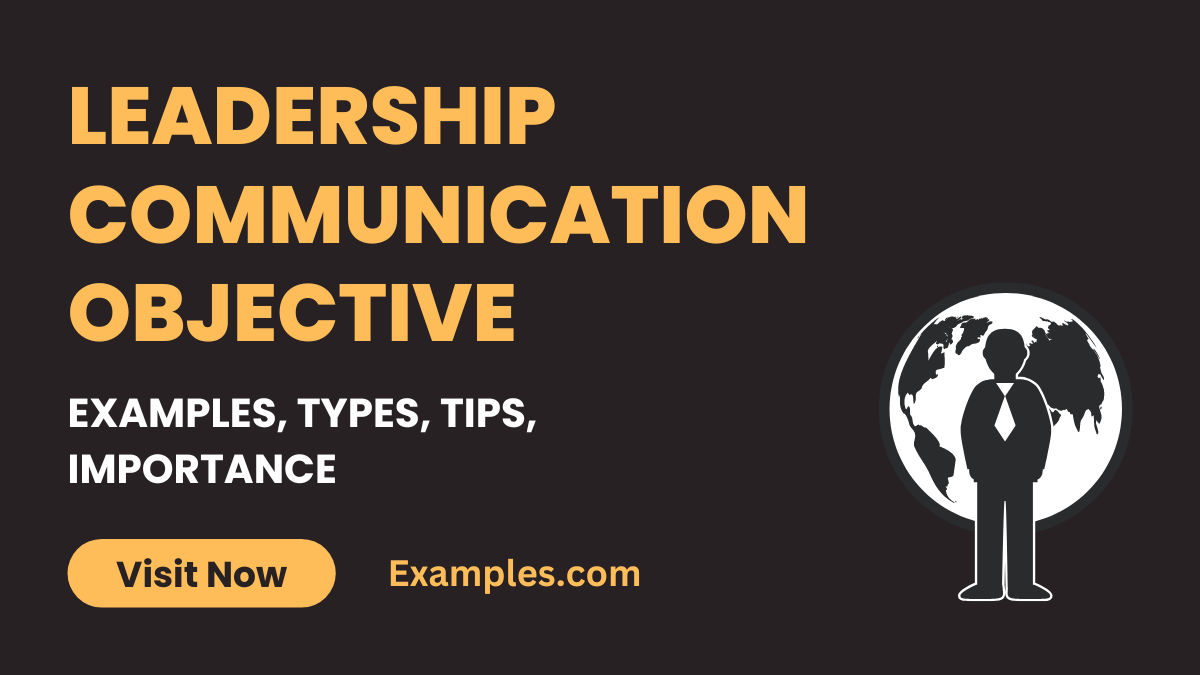19+ Leadership Communication Objective Examples
In the realm of leadership, communication plays a pivotal role in achieving objectives. This guide delves into the essence of Leadership Communication Objective, offering a comprehensive exploration of its importance, types, and practical applications. We’ll illuminate the concept with vivid communication examples, providing an insightful journey for leaders and aspiring influencers alike. Learn to harness the power of effective communication in leadership for impactful results.
Download Leadership Communication Objectives PDF
Download Leadership Communication Objectives Table PDF
What is the Leadership Communication Objective?
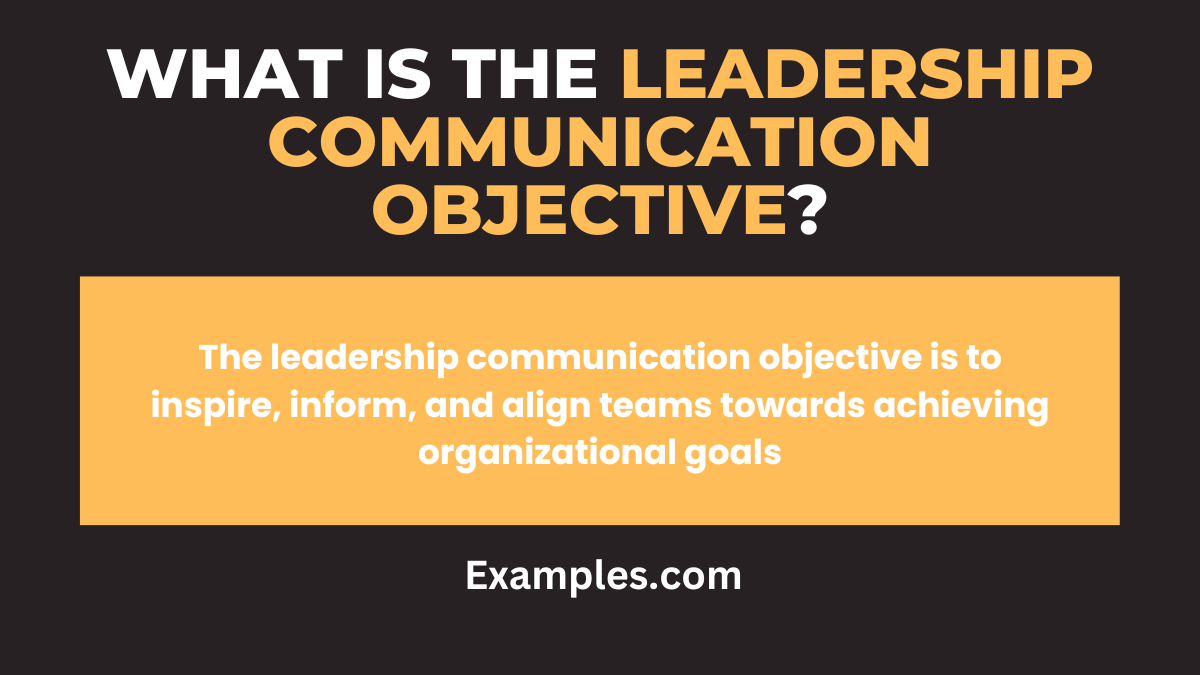
The Leadership Communication Objective refers to the strategic approach leaders use in conveying messages to influence, guide, and motivate their team or organization towards specific goals. It’s not just about what is said, but how it is communicated to inspire action and foster a supportive environment. This objective integrates various aspects like employee motivation communication objective and stakeholder trust building communication objective, ensuring that leaders effectively engage with their teams and stakeholders to achieve desired outcomes.
What is the Best Example of Leadership Communication Objective?
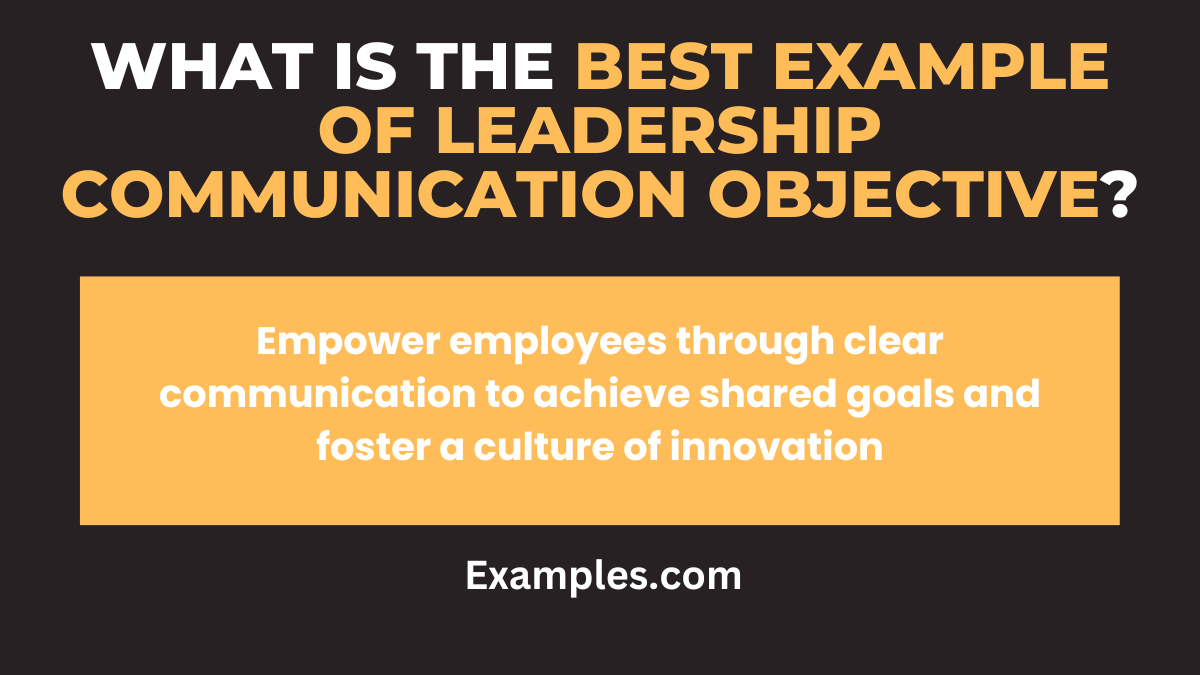
A prime example of the Leadership Communication Objective is a CEO implementing an awareness building communication objective during an organizational change. This might involve clearly explaining the reasons for the change and its expected benefits, using persuasion communication objective to align the team with the new vision. The CEO’s communication would aim to minimize resistance, foster understanding, and encourage a smooth transition, illustrating how strategic communication can effectively guide an organization through critical changes.
20 Leadership Communication Objective Examples
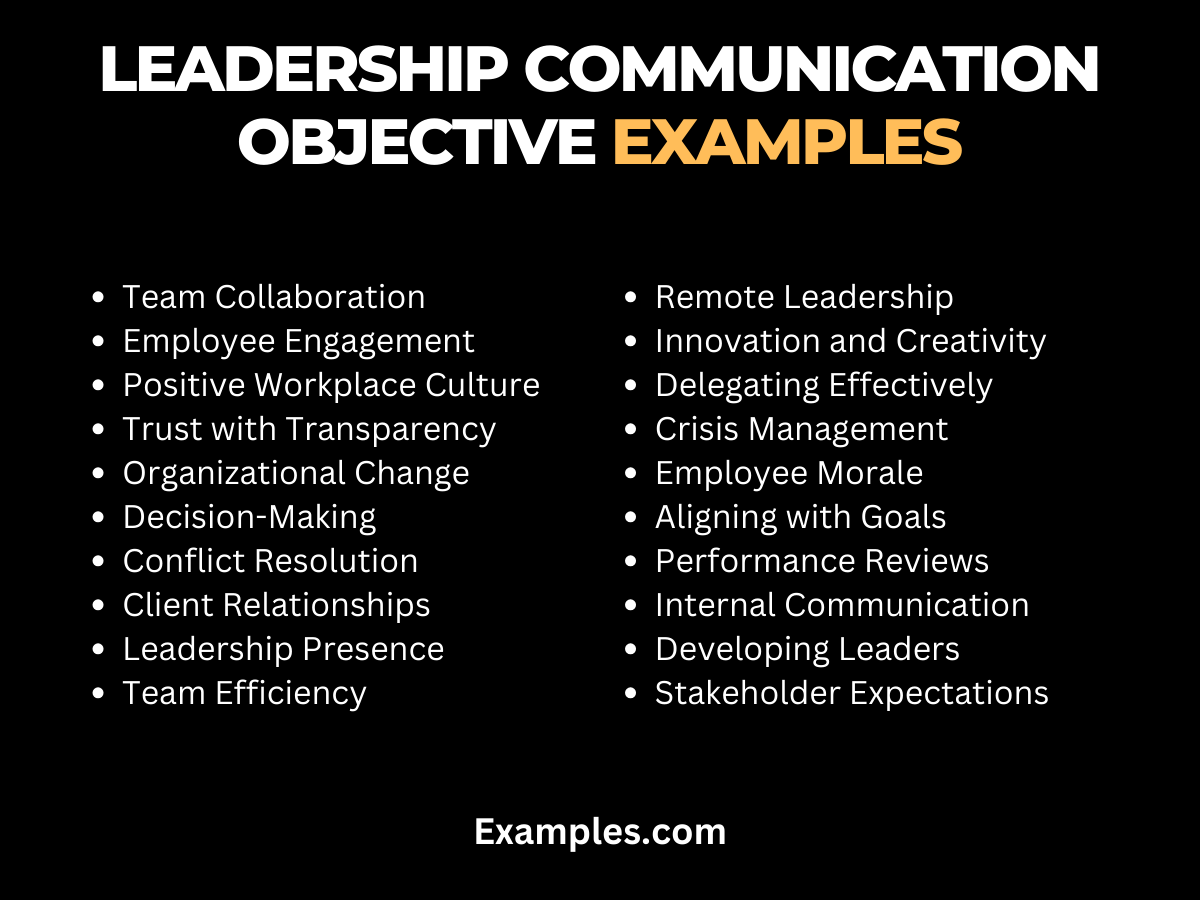
Discover the diverse facets of leadership communication objectives through these 20 unique and insightful examples. Each example showcases a different scenario in leadership communication, examining the causes and offering solutions to enhance effectiveness. This guide is enriched with strategic communication skills, effective leadership dialogue, and influential leadership messaging, providing leaders with practical insights on how to communicate effectively in various situations. Dive into these examples to understand the nuances of leadership communication and how it can be optimized for success.
- Enhancing Team Collaboration: Poor collaboration often stems from unclear objectives. A leader can rectify this by setting clear team communication strategies, ensuring everyone understands their roles and how they contribute to the team’s success.
- Improving Employee Engagement: Low engagement can result from a lack of motivation. Leaders can use leadership persuasion techniques to inspire and motivate their team, improving engagement and productivity.
- Fostering a Positive Workplace Culture: Negative culture may arise from ineffective communication. Utilizing organizational communication methods can help in building a positive and inclusive culture.
- Building Trust with Transparency: Trust issues often occur when there’s a lack of openness. Leaders can overcome this by practicing leadership influence and interaction with honesty and transparency.
- Navigating Organizational Change: Resistance to change can be due to fear or misunderstanding. Executive communication tactics can help in clearly explaining the reasons for change and how it benefits everyone.
- Enhancing Decision-Making Processes: Confusion in decision-making often results from a lack of clear direction. Leaders can improve this by employing team building communication, ensuring all team members are on the same page.
- Resolving Interpersonal Conflicts: Conflicts may arise from miscommunication or misunderstanding. Effective leadership verbal skills can help in mediating and resolving such conflicts.
- Strengthening Client Relationships: Weak client relationships can stem from inadequate communication. Leaders should focus on leadership communication training objectives to enhance client interactions and satisfaction.
- Improving Leadership Presence in Meetings: Ineffectiveness in meetings can be due to poor communication skills. Focusing on leadership communication objectives in the workplace helps leaders become more impactful during meetings.
- Increasing Team Efficiency: Inefficiency can result from unclear instructions. Leaders can address this by emphasizing the importance of communication in leadership, ensuring that instructions and expectations are clear.
- Leading Remote Teams Effectively: The challenge of remote leadership often lies in the distance barrier. Implementing leadership communication objectives in market research can help in understanding and overcoming these challenges.
- Encouraging Innovation and Creativity: A lack of new ideas may be due to restrictive communication. Leaders can foster an environment of open dialogue and brainstorming through communication objectives examples.
- Delegating Responsibilities Effectively: Ineffective delegation can occur due to miscommunication. Leaders should use types of communication objectives to ensure clarity in delegation and responsibility.
- Handling Crisis Management: Poor crisis management often results from panic and misinformation. Crisis communication objectives help leaders to communicate calmly and effectively during crises.
- Boosting Employee Morale: Low morale can be a result of feeling undervalued. Using employee motivation communication objectives helps leaders to recognize and appreciate their team’s efforts, boosting morale.
- Aligning Team with Organizational Goals: Misalignment can occur when goals are not communicated effectively. Leaders should use strategic communication objectives to align team efforts with organizational goals.
- Conducting Effective Performance Reviews: Ineffective reviews often result from a lack of constructive feedback. Leaders can improve this through communication objectives in business, focusing on constructive, growth-oriented feedback.
- Enhancing Internal Communication: Poor internal communication can lead to confusion and inefficiency. Leaders should focus on communication objectives in an organization to streamline and improve internal communication.
- Developing Leadership in Others: A lack of emerging leaders can be due to inadequate mentorship. Leaders can address this by setting leadership communication objectives for treatment plans, focusing on developing future leaders.
- Managing Stakeholder Expectations: Mismanaged expectations often arise from poor communication. Leaders can use communication to stakeholders objectives to ensure clear, consistent, and regular communication with all stakeholders.
Leadership Communication Training Objective
Effective leadership communication training is crucial for enhancing leadership effectiveness and team dynamics. This training focuses on developing strategic communication skills and effective leadership dialogue to ensure leaders can convey their vision and motivate their teams efficiently.
- Developing Empathetic Listening Skills: Train leaders to actively listen, fostering a deeper understanding of team needs.
Example: “I hear your concerns about the project timeline; let’s discuss possible solutions.” - Enhancing Non-Verbal Communication: Focus on body language and tone to complement verbal messages.
Example: “Your presentation was excellent,” said with a genuine smile and eye contact. - Mastering Persuasive Communication: Teach leaders to persuade and influence without coercion. Example: “Let’s explore how this strategy benefits us all in the long run.”
- Improving Conflict Resolution Techniques: Equip leaders with skills to manage and resolve conflicts effectively.
Example: “I understand both points of view; let’s find a middle ground.” - Building Public Speaking Confidence: Enhance leaders’ abilities to speak confidently in public settings. Example: “Today, I will share our vision for the future with enthusiasm and clarity.”
Leadership Communication Objective in the Workplace
Leadership communication in the workplace is essential for maintaining a positive work environment and achieving organizational goals. It involves utilizing team communication strategies and leadership influence and interaction to effectively guide and support the team.
- Ensuring Clarity in Instructions: Make objectives and expectations crystal clear.
Example: “To clarify, the project deadline is next Friday, and here’s what we need to achieve.” - Promoting Open and Honest Dialogue: Encourage transparent communication to build trust.
Example: “I value your honest feedback on our current processes.” - Facilitating Effective Team Meetings: Conduct meetings that are concise, focused, and productive. Example: “Let’s focus on the key points to make this meeting as effective as possible.”
- Encouraging Constructive Feedback: Create a culture where feedback is welcomed and acted upon. Example: “Your suggestions for improvement are invaluable to our team.”
- Supporting Employee Development: Communicate regularly about career growth and opportunities. Example: “Let’s discuss your career aspirations and how we can support your growth.”
Importance of Communication in Leadership
Communication in leadership is vital for the success of any team or organization. It encompasses leadership persuasion techniques and executive communication tactics to effectively guide, motivate, and engage team members.
- Building Team Cohesion: Effective communication fosters a sense of unity and teamwork.
Example: “Together, we can achieve our common goals and overcome challenges.” - Facilitating Change Management: Clear communication is key during organizational changes.
Example: “Here’s how the upcoming changes will benefit our team and company.” - Enhancing Decision-Making Processes: Open communication leads to informed and collaborative decisions.
Example: “Let’s gather everyone’s input to make the best decision.” - Strengthening Leader-Follower Relationships: Trust and respect are built through consistent and honest communication.
Example: “I’m committed to being open and transparent with all of you.” - Promoting Innovation and Creativity: Encourage sharing of ideas and constructive feedback.
Example: “I encourage you all to bring forward your innovative ideas.”
How to Improve Leadership Communication?
- Practice Active Listening: Show genuine interest in team members’ ideas and concerns.
- Tailor Your Message: Adjust your communication style to suit your audience.
- Be Consistently Transparent: Maintain honesty and openness in all communications.
- Use Positive Reinforcement: Acknowledge and appreciate good work to motivate your team.
- Develop Empathy: Understand and consider your team’s perspectives and feelings.
- Encourage Two-Way Communication: Foster an environment where feedback is actively sought and valued.
- Keep Learning: Continuously seek to improve your communication skills through training and practice.
What are the Goals of Leadership Communication Objective?
- Aligning Team with Vision: Ensure everyone understands and works towards the organization’s goals.
- Building a Cohesive Team: Create a sense of unity and teamwork among members.
- Facilitating Change Management: Communicate effectively to guide teams through transitions.
- Enhancing Employee Performance: Use communication to motivate and improve team performance.
- Managing Stakeholder Expectations: Keep stakeholders informed and engaged with regular updates.
- Resolving Conflicts: Use communication skills to address and resolve disputes.
- Cultivating a Positive Workplace Culture: Foster an environment of respect and collaboration.
Types of Leadership Communication Objective
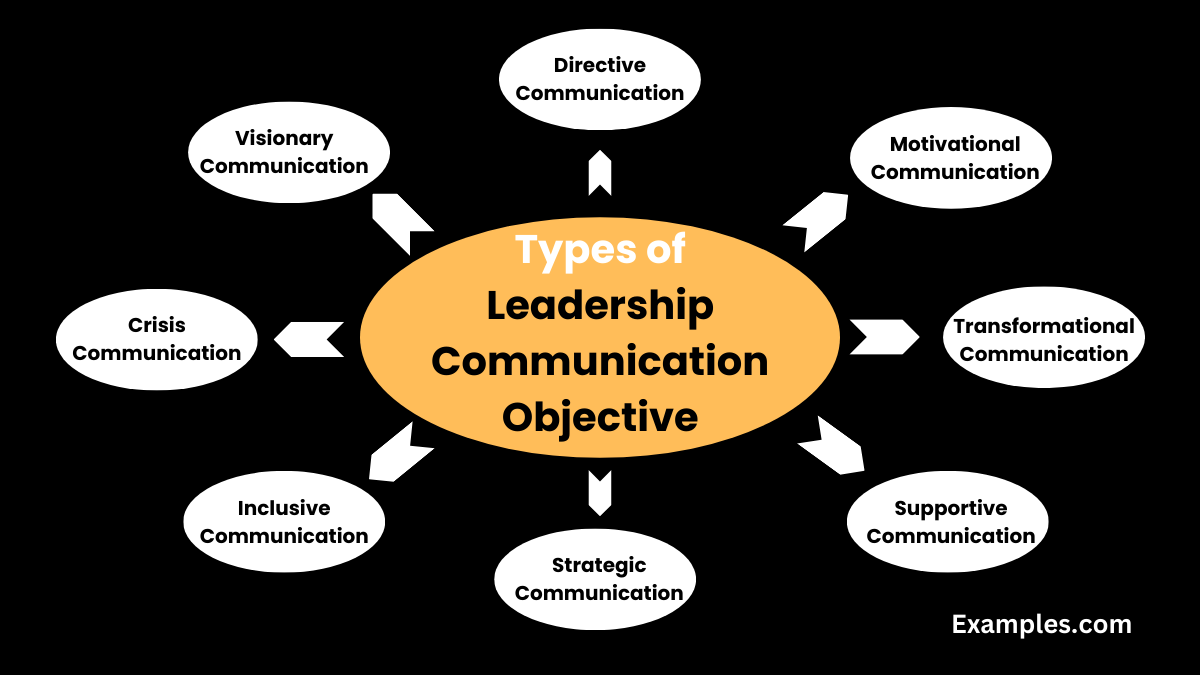
- Directive Communication: Giving clear, specific instructions to team members.
- Motivational Communication: Inspiring and encouraging the team towards goals.
- Transformational Communication: Communicating a vision that excites and transforms the team.
- Supportive Communication: Providing support and reassurance to team members.
- Feedback-Oriented Communication: Offering constructive feedback for improvement.
- Inclusive Communication: Ensuring every team member feels heard and valued.
- Crisis Communication: Effectively communicating during emergencies or critical situations.
Tips for Leadership Communication Objective
- Be Clear and Concise: Avoid ambiguity to ensure your message is understood.
- Show Authenticity: Be genuine in your communication to build trust.
- Use Stories and Examples: Make your communication relatable and memorable.
- Adapt to Your Audience: Understand and respect the diversity of your team.
- Stay Positive: Maintain a positive tone, even in challenging situations.
- Focus on Listening: Give your full attention to others when they speak.
- Seek Feedback: Continuously improve by asking for and acting on feedback.
One of the key components of leadership communication is the ability to clearly articulate a vision and inspire others to follow. This involves not just the content of the message but also the way it’s delivered. Leaders must be adept at using various communication methods to connect with their audience, whether through speeches, written communication, or digital platforms. The Harvard Business School Online offers insightful resources on how to effectively communicate as a leader, which you can explore here.
Moreover, effective leadership communication also includes the capacity to listen and engage in two-way dialogues. This ensures that leaders not only disseminate information but also receive feedback and insights from their team members. The Center for Creative Leadership provides a comprehensive guide on this topic, highlighting one fundamental idea, three critical facts, and five practical tips to enhance leadership communication. Learn more about this approach here.



